My most memorable mikveh meeting
Published January 25, 2012
One of the most memorable events during my long career at the Jewish Light took place in July of 1978 at the home of the late Rabbi Menachem Zvi Eichenstein and the late Rebbetzin Renee Eichenstein. That’s when the two invited internationally noted sex researchers William Masters and Virginia Johnson to dinner, and included me as well.
Lest you believe that I am making up this get-together, I was there and have the photos taken by former Light photographer David Henschel to prove it.
ADVERTISEMENT
Rabbi Eichenstein, who was the immediate predecessor to the late Rabbi Sholom Rivkin as Chief Rabbi of the Vaad Hoeir/United Orthodox Jewish Community of St. Louis, was in the midst of a major fund-raising campaign to build a new mikveh, or Jewish ritual bath. The new facility was to be built on the grounds of the Millstone Jewish Community Campus, replacing the original one built in 1948 at 6128 Delmar Boulevard. The rabbi’s proposal was met with some resistance by local Jews who questioned why a community-wide campus should provide space for a facility that served “only the Orthodox” portion of the community. In fact, the mikveh is used by members of all streams of the Jewish community for purposes of conversion as well its most central function, to fulfill the commandments relating to niddah, or women during the duration of their menstrual flow.
According to traditional Jewish practice, it is forbidden for men and women to have sexual intercourse when the woman is a niddah, which includes the duration of the menstrual flow (counted as a minimum of five days, plus a “dormancy period” of seven days). After the seven blood-free days, the Jewish woman visits the mikveh where she will bathe herself thoroughly and then will be immersed in the waters of the mikveh (Hebrew for “gathering of waters”). After immersion, a couple can resume their normal sex life.
Realizing that there were many members of the general Jewish community who were not familiar with the practices associated with the mikveh, Rabbi and Rebbetzin Eichenstein hit upon the ingenious idea of inviting to dinner the acclaimed sex researchers Masters and Johnson. Their pioneering research as directors of the Reproductive Biology Research Foundation in St. Louis had the biggest impact on scientific knowledge of sexual issues since the groundbreaking research of Dr. Alfred Kinsey a generation earlier.
What better way to spread up-to-date understanding of the meaning-and real value-of the practices associated with the mikveh than to enlist the two foremost experts on human sexuality at the time?
In the midst of the incredibly tasty kosher dinner in the Eichenstein dining room, Bill Masters, a somewhat reserved and scholarly man, and Virginia Johnson, who exuded warmth, found great modern value to the practices of the mikveh, especially in the area of enhanced sexual enjoyment.
ADVERTISEMENT
Masters and Johnson had just published their third book, “The Pleasure Bond,” in which they discuss the problems many couples encounter when “the magnetism of their bodies seems to lose its force,” resulting in “a gradual decline of sexual excitement.” Rabbi Eichenstein agreed, stating, “The need for renewal of sexual desire is not limited to women…Men have taken for granted (sexual) activities, that they too, need something to renew their sexual desire.”
Johnson said that she found Rabbi Eichenstein’s comments on the practice of mikveh to be “fascinating and informative,” and indicated that such practices, if important to the couple, and if accompanied by a generally healthy attitude toward sexuality, can contribute to the enhancement of sexual enjoyment. She praised the Jewish community for its “openness and candor in matters relating to sexuality,” and noted that the overwhelming majority of those seeking counseling at the Masters and Johnson clinic were members of the Jewish community.
Dr. Masters said that the approach to dealing with sexual issues “must be interdisciplinary and must involve not only physicians and therapists, but religious leaders as well.” He welcomed referrals from the Orthodox community and the opportunity to share perspectives with the Orthodox rabbinate.
Rabbi and Rebbetzin Eichenstein were ultimately successful in obtaining the space on the Millstone campus for the construction of the mikveh, which is now used by the entire Jewish community in increasing numbers.

















